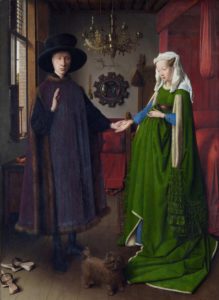London’s National Gallery has recently stirred up a storm in the art world by replacing the frame for one of its main attractions, Jan van Eyck’s Arnolfini Wedding. This seemingly innocuous act has unexpectedly sparked a heated debate, leaving part of the art community divided.
The National Gallery recently announced that they changed the frame for the Northern Renaissance masterpiece, replacing the ornate, nineteenth-century Gothic revival frame in favor of a far older, period-appropriate, gilded, fifteenth-century frame. Peter Schade, head of the National Gallery’s framing department, announced this change on social media. Schade commented that the details now appear “crisper” with the new frame since it lacks any “incongruous carving”.
Created in 1434, The Arnolfini Wedding is a double portrait, the subject of which has been contested in recent years. The previous consensus among art historians is that the portrait shows the Italian merchant Giovanni di Nicolao Arnolfini and his wife Jeanne Cenami. However, in the late 1990s, an art historian named Lorne Campbell, who served as the National Gallery’s senior research curator, uncovered that the couple would not marry until over a decade after the work’s creation. This has led some to claim that the painting shows Arnolfini with his first wife, Costanza, who died the year before. This means that the painting is both a portrait and a memorial. This explains some of the imagery in the portrait, of which there is a great amount. For example, art historians previously believed that the woman’s pregnant appearance represents a contemporary beauty standard. Having a fuller figure meant using more fabric for your clothing, emphasizing wealth. However, if the portrait shows Costanza, it gains new meaning as a memorial since she died in childbirth. This is reinforced by the chandelier above them, which has only one lit candle facing Giovanni. Furthermore, the convex mirror in the background is surrounded by small roundels showing scenes from Christ’s passion, while a small figurine likely representing Saint Margaret the Virgin stands on the bedpost to the right. Christ’s passion represents death, while Saint Margaret is the patron saint of childbirth.
While the new frame has garnered some positive feedback, it has also faced its fair share of criticism. In response to Schade’s post, one social media user boldly declared, “Respect 19th-century aesthetics!” But should we disregard the original intent of the artist? There’s a fundamental truth that those trained in history understand: the veneer of authenticity is not the same as accuracy. It is the prerogative of future generations of art historians, curators, restorers, and conservators to interpret the historical record and make decisions on how to display works of art and educate the public. Therefore, the opinion of amateurs claiming that the old frame, which is actually the newer frame, seems more accurate for the painting holds no weight. If the top specialists in Northern Renaissance painting assert that a simple, gilt frame is most representative of how such a painting would’ve been displayed at the time of its creation, then it is not our place to argue.

